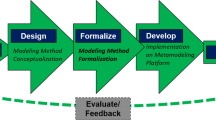Abstract
The aim of this paper is to provide the first steps toward a formal theory of model integration. This is supported at least by three arguments: (a) increasing the productivity of the modeling work; (b) decreasing errors; (c) saving time and money. Of course, any formal theory has to be based on a given framework; in our case, we consider only models which satisfy the core concepts of Structured Modeling. The outline of the paper is as follows. After the motivations are pointed out, some preliminary results are given in section 2. Section 3 defines the levels of integration, while in sections 4 and 5 some examples are presented. Remarks and future extensions conclude the paper.
Similar content being viewed by others
References
A. Andronico, L. Cossa, M. Gagliardi and C. Spera, An object oriented approach to a model management system: Characteristics and examples,Proc. 36th Annual ANIPLA Conf., ed. Bottaro and Zoppoli (Pirella, Genoa 1992).
G.H. Bradley and R.D. Clemence, Jr., Model integration with a types executable modeling language,Proc. 21st Annual Hawaii Int. Conf. on System Sciences, Vol. 3 (IEEE Computer Society Press, Washington, 1988) pp. 403–410.
D.R. Dolk and J.E. Kotteman, Model integration and a theory of models, Dec. Support Syst. 9 (1993) 51–63.
M. Gagliardi and C. Spera, BLOOMS: Basic Language Object Oriented for Modeling Systems, Working Paper No. 11, Department of Quantitative Methods, University of Siena, Italy (1994).
M. Gagliardi and C. Spera, The syntax of BLOOMS, Part I: Introduction, Working Paper No. 10. Department of Quantitative Methods, University of Siena (1994).
M. Gagliardi and C. Spera, The syntax of BLOOMS, Part II: Grammar, Draft Technical Report, Department of Quantitative Methods, University of Siena (1994).
A.M. Geoffrion, An introduction to structured modeling, Manag. Sci. 33(1987)547–589.
A.M. Geoffriom, Integrated modeling systems, Comp. Sci. Econ. Manag. 2(1989)3–15.
A.M. Geoffrion, The formal aspects of structured modeling, Oper. Res. 37(1989)30–51.
A.M. Geoffrion, Reusing structured models via model integration, in:Current Research in Decision Support Technology, ed. R. Blanning and D. King (IEEE Computer Society Press, 1990).
A.M. Geoffrion, The SML language for structured modeling, Oper. Res. 40(1992)38–75.
J.E. Kottemann and D.R. Dolk, Model integration and modeling languages: A process prospective, Inf. Syst. Res. 3(1992)1–16.
W. Muhanna and R. Pick, Composite models in SYMMS,Proc. 21st Annual Hawaii Int. Conf. on System Sciences, Vol. 3 (IEEE Computer Society Press, Washington, 1988) pp. 418–427.
Y. Tasi, An operational approach to model integration using a structured modeling framework,Proc. 1993 Pan Pacific Conf. on Information Systems, Kaohsiung, Taiwan (1987). Full version: Research Paper, Anderson Graduate school of Management, UCLA.
Author information
Authors and Affiliations
Additional information
On leave from the University of Siena on a fellowship from CNR, Italy. Permanent address: Department of Quantitative Methods, Piazza S. Francesco 17, I-53100 Siena, Italy (contact author).
Rights and permissions
About this article
Cite this article
Gagliardi, M., Spera, C. Toward a formal theory of model integration. Ann Oper Res 58, 403–440 (1995). https://doi.org/10.1007/BF02032379
Issue Date:
DOI: https://doi.org/10.1007/BF02032379




